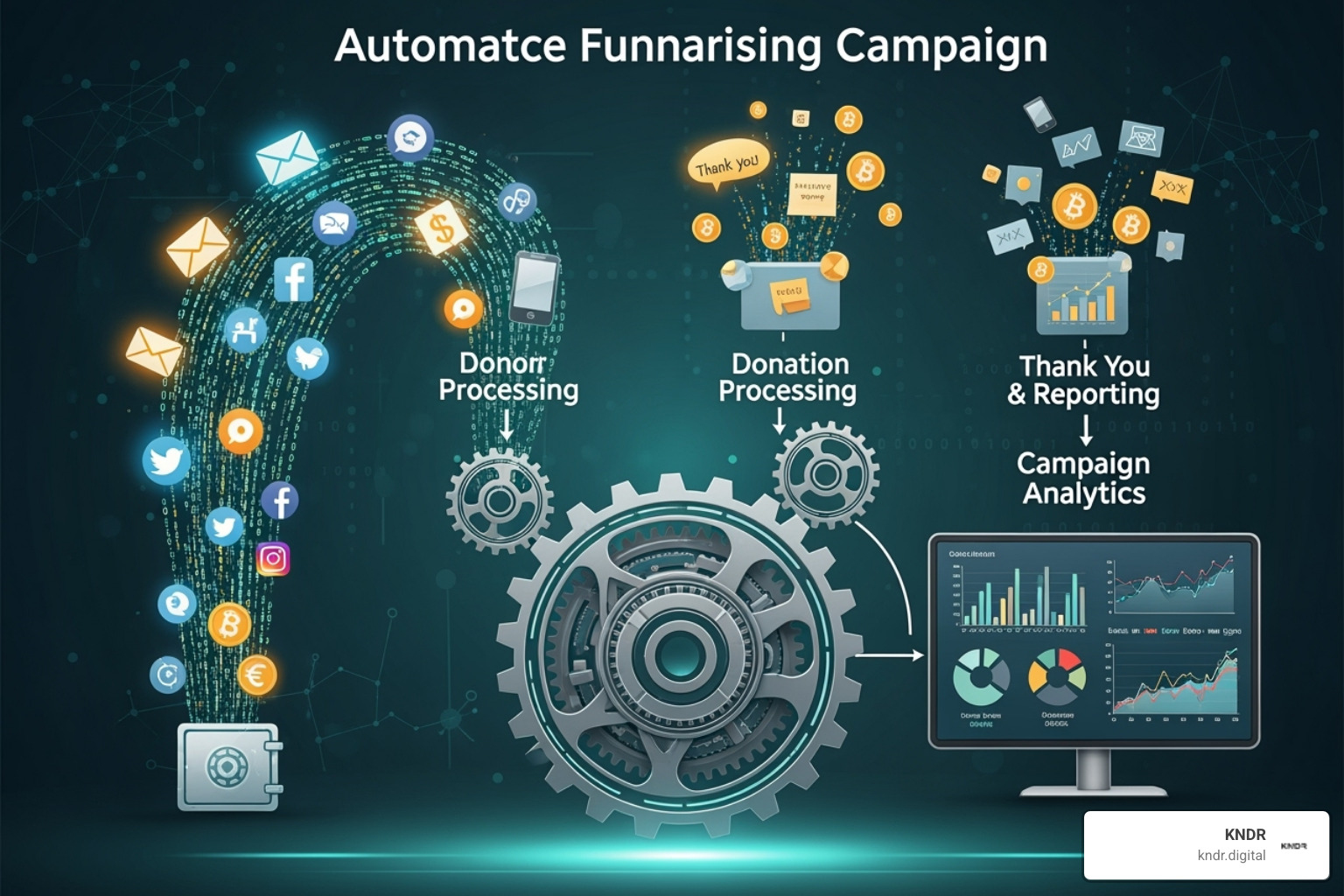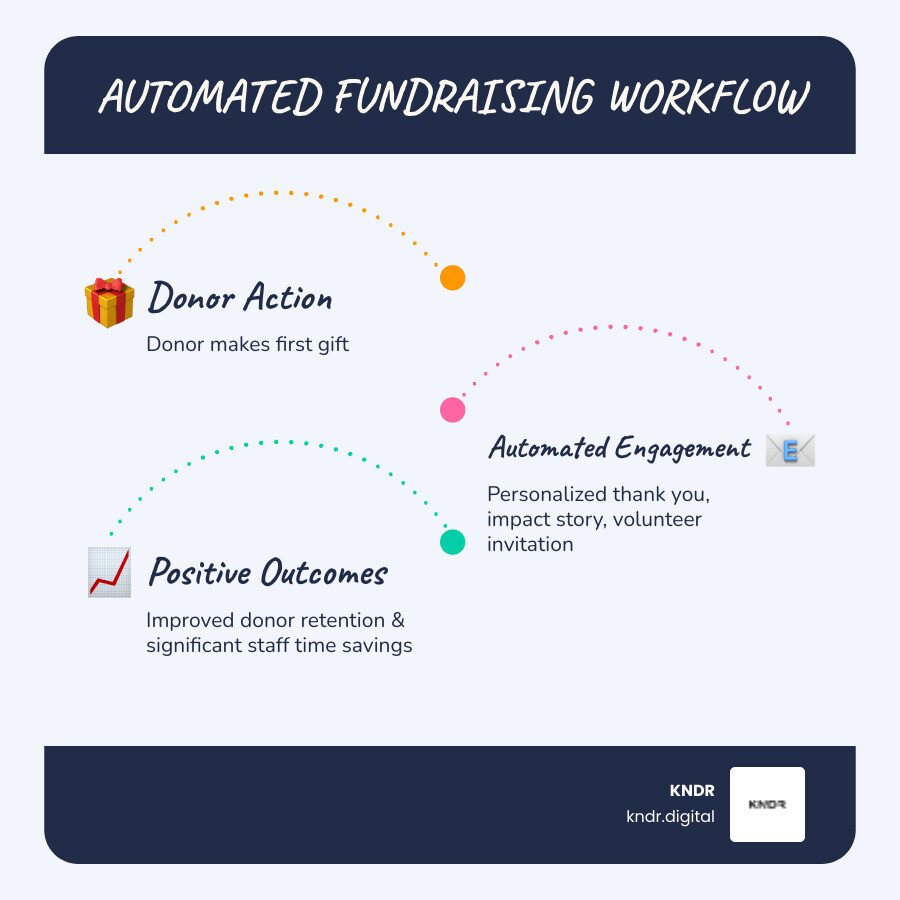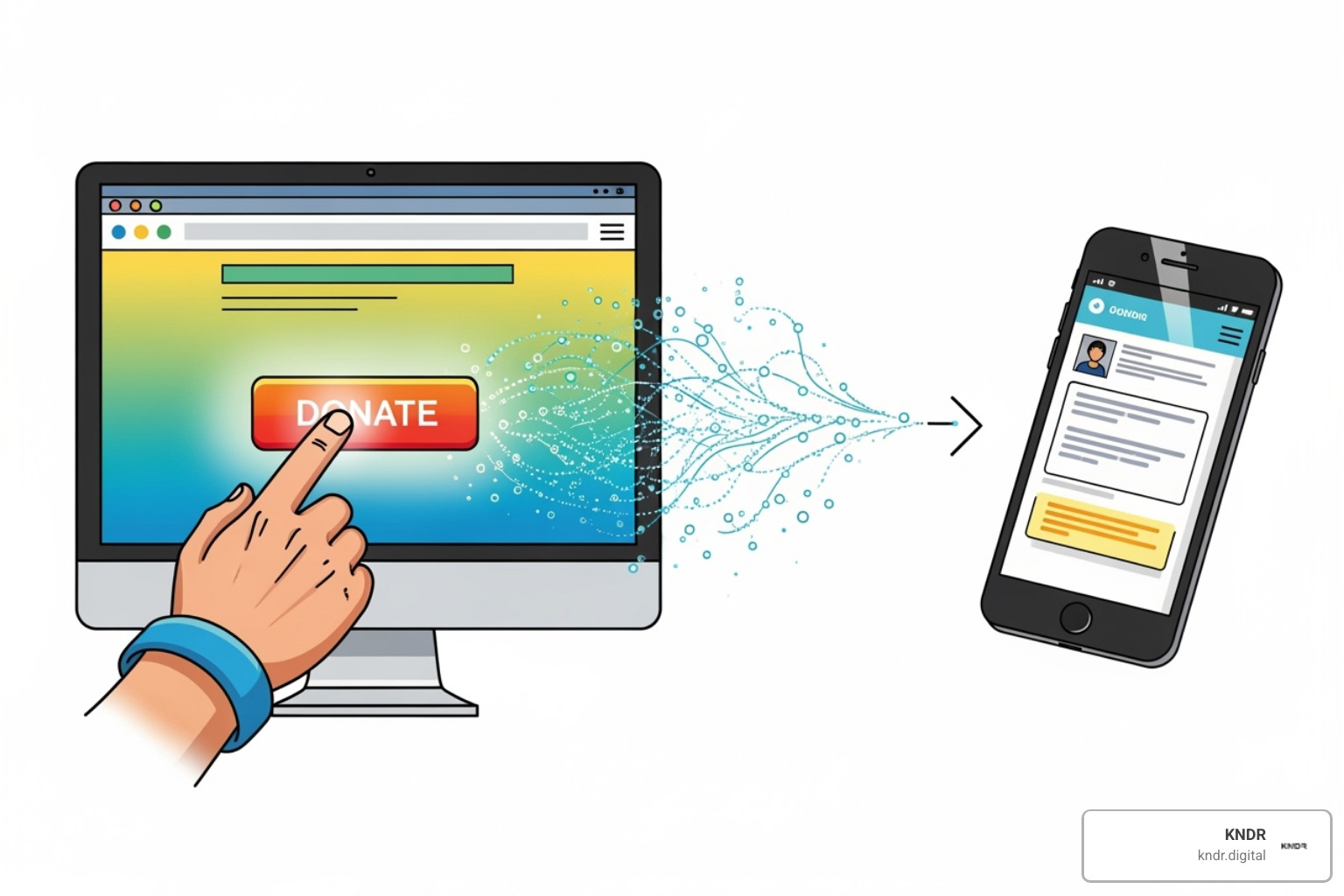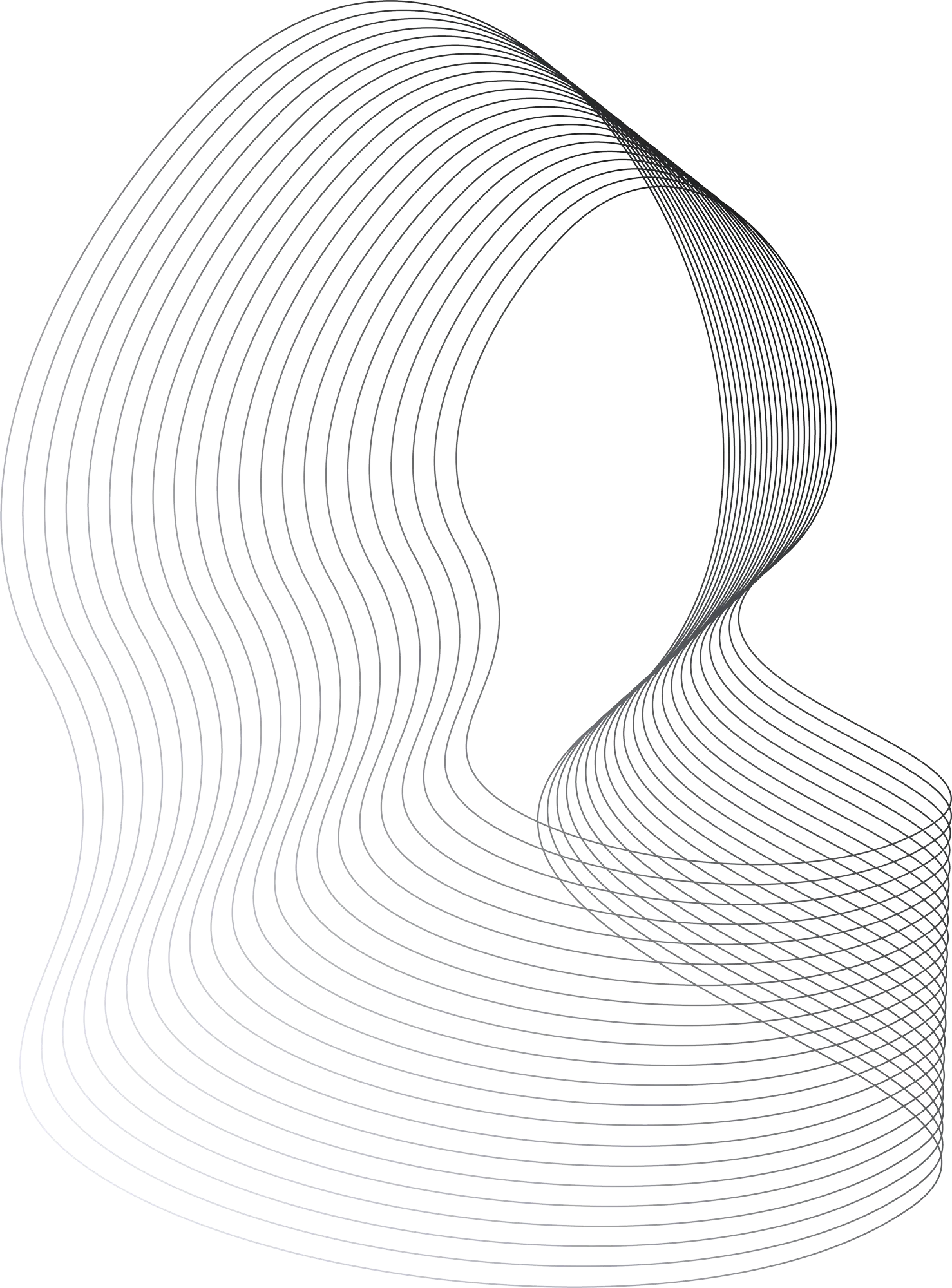Fundraising on Autopilot: Your Guide to Campaign Automation

Why Automated Fundraising Campaigns Are Essential for Nonprofits Today
Automated fundraising campaigns use software to streamline donor communications and engagement tasks without constant manual effort. These systems handle everything from sending thank-you emails to managing recurring donations based on donor behavior and preferences.
Key Benefits of Automated Fundraising:
- Time Savings: Eliminate repetitive tasks like manual data entry and follow-up emails
- Better Donor Retention: First-time donors who receive personalized thank-yous within 48 hours are 4x more likely to donate again
- Consistent Communication: Never miss important touchpoints with supporters
- Scalable Growth: Manage more donors without adding staff
- Data-Driven Insights: Track what works and optimize campaigns automatically
If you're a nonprofit director struggling with stagnant donations and limited staff time, you're not alone. 13% of first-time donors never receive a thank you - a missed opportunity that automation can fix.
The challenge isn't just about sending more emails. It's about creating meaningful donor journeys that build lasting relationships while freeing your team to focus on strategy instead of administrative tasks.
Modern nonprofits are finding that automation doesn't make fundraising less personal - it makes personalization possible at scale. When your systems can automatically segment donors, send targeted messages, and track engagement, you can focus on the high-value work that truly moves your mission forward.
I'm Mahir Iskender, CEO of KNDR.digital, where I help mission-driven organizations implement automated fundraising campaigns that increase donor engagement and streamline operations. Over the past decade, I've guided nonprofits through digital change strategies that combine AI-powered marketing with performance-based growth approaches.

Automated fundraising campaigns terms explained:
What is Fundraising Automation and Why It's a Game-Changer
Picture this: it's Monday morning, and instead of scrambling to send thank-you emails from last week's donations, your team is brainstorming creative ways to engage major donors. That's the power of automated fundraising campaigns in action.
Fundraising automation uses smart software to handle the repetitive tasks that eat up your day. It's like having a tireless assistant who never forgets to send a thank-you note, always remembers donor preferences, and can juggle hundreds of conversations at once without breaking a sweat.
But here's where it gets exciting - this isn't just about saving time on data entry. Workflow automation creates entire donor journeys that respond to real behavior. When someone makes their first $25 donation, your system instantly knows to send them a different welcome series than your $500 major donor. It's personalization at scale, something that would be impossible to do manually.
The magic happens through data-driven insights. Every click, every donation, every email opened teaches your system more about what your donors want. This means improved personalization that actually feels personal, not robotic.
Most importantly, automation dramatically improves donor retention. When supporters feel heard and valued through timely, relevant communications, they stick around. And when they stick around, your mission gets the consistent funding it deserves.
If you're ready to dive deeper into how AI is changing nonprofit work, check out our guide on AI Nonprofit Fundraising.
The Core Benefits of Automation
Here's what happens when you put your fundraising on autopilot: everything gets better, and your team gets their sanity back.
Time savings is the obvious win. Those hours spent copying and pasting donor names into email templates? Gone. That mental load of remembering to follow up with every new supporter? Handled automatically.
But the real game-changer is how automation lets you scale your fundraising efforts without burning out your team. You can nurture 1,000 donors with the same attention to detail you'd give to 100. Your messages arrive at the perfect moment - not three days late because someone was sick or overwhelmed.
Communication consistency becomes effortless. No more wondering if that new board member got the welcome packet, or if last month's donors received their impact updates. Your system ensures everyone gets the right message at the right time, every time.
Perhaps most valuable is the deeper donor knowledge you'll gain. Automation tracks everything - which emails get opened, what donation amounts trigger the most engagement, and which stories resonate with different donor segments. This intelligence helps you make smarter decisions about everything from campaign timing to messaging strategy.
Powerful statistic? First-time donors who receive personalized communication within 48 hours are 4x more likely to donate again. That's not just a number - it's proof that when you get the basics right automatically, you create space for the relationship-building that really matters.
Ready to explore more ways to modernize your approach? Our Digital Fundraising Strategies guide has everything you need to get started.
The Mechanics: How Triggers, Conditions, and Actions Work
How do automated fundraising campaigns work? It's not magic, but a simple system based on "if/then" logic. Think of it as a smart assistant that knows what to do, when, and for whom. If a specific event happens (trigger), and certain rules are met (conditions), the system performs a task (action). This three-part framework—Triggers, Conditions, and Actions—is the engine behind every successful automated workflow.

- Triggers are the starting point for any automated sequence. They are the 'if' in the equation, signaling that an event has occurred, like a first donation or a newsletter signup. These critical events set the automation in motion.
- Conditions are the 'who' and 'what' filters. They refine the automation, ensuring the right message goes to the right person. Conditions use details like giving history or engagement to personalize actions, such as checking if a donation is over $50.
- Actions are the 'then' part of the equation—the tasks your system performs. This could be sending a thank-you email, updating a CRM record, or creating a follow-up task for your team. Actions are where automation delivers results.
Some common automation triggers you might use include:
- A donor making their first donation
- Someone opening a newsletter or clicking a specific link
- A supporter registering for an event
- A donor showing lapsed giving (no donation in a certain period)
- A donor reaching a specific giving level
- Someone submitting a volunteer application
- A donor updating their contact information in your CRM
Example Workflow: The First-Time Donor
Let's look at a real-world example: welcoming a new donor. When someone makes their first gift, automation can ensure they receive immediate appreciation and are set on a path to lasting engagement.
Here’s how an automated workflow for a first-time donor might work:
- Trigger: A first donation is received.
- Condition: The donation amount is greater than $50.
- Action 1: An instant, personalized thank-you email is sent with a tax receipt and a message about the gift's impact.
- Action 2: An automated task is created in your CRM for a staff member to make a personal follow-up call within 48 hours.
This powerful workflow ensures no new donor feels like a number. It builds a strong, long-term relationship without constant manual oversight, turning a one-time transaction into a lifelong connection.
More info about Automated Donation System
5 Key Fundraising Journeys to Automate Today
Now, let's explore five impactful automated fundraising campaigns you can implement to nurture relationships, save time, and boost fundraising.
1. The New Donor Welcome Series
A new donor's first interactions are critical. A well-crafted automated welcome series significantly increases the chance of a second gift.
- Instant Receipt: Immediately after a donation, the system sends a tax-deductible receipt, confirming the transaction.
- Personalized Thank-You Email: Within 24-48 hours, send a warm, personalized email focusing on the gift's impact. Share a story or photo to show their contribution's value without an immediate second ask.
- Impact Story: A few days later, send a follow-up email with a deeper impact story to strengthen their emotional connection to your mission.
- Engagement Opportunities: A week or two later, a final email can introduce other ways to get involved, like signing up for a newsletter, following on social media, or volunteering.
This sequence makes new donors feel valued and connected, setting the stage for future engagement.
More info about AI-Driven Email Campaigns
2. Lapsed Donor Re-engagement Campaigns
Donors sometimes stop giving, but they aren't lost forever. Automated fundraising campaigns can effectively re-engage these valuable supporters.

- Dynamic Segmentation: Automatically identify donors who haven't given in a specific timeframe (e.g., 6, 12, or 24 months).
- Personalized Appeal: Trigger a personalized "We Miss You" email that acknowledges their past support and reminds them of their potential impact. Highlight a new project or success story.
- Feedback Survey: Send an automated email with a short feedback survey to understand why they stopped giving. This provides invaluable insights for improvement.
- Success Story: If there's no response, a final email can share a powerful success story, reminding them of their past impact and inviting them to give again.
Automating re-engagement prevents valuable donors from slipping away.
3. Recurring Donor Nurturing and Upgrades
Recurring donors provide consistent revenue. Automation helps nurture these key relationships and encourage increased giving.
- Milestone Recognition: Automate emails to celebrate giving anniversaries (e.g., one year of monthly gifts), acknowledging their consistent support with personalized messages or impact totals.
- Exclusive Impact Updates: Send automated monthly or quarterly updates on projects their contributions are funding to reinforce their decision to give.
- Automated Upgrade Asks: After 12-18 months of consistent giving, an automated email can suggest a small increase to their monthly donation, highlighting the additional impact.
- Credit Card Recovery Workflows: Automated workflows can detect failed payments from expired credit cards, send reminders to update payment information, and retry payments to reduce passive churn.
These campaigns ensure your most loyal supporters feel appreciated and informed.
More info about Implementing AI for Donor Retention: The Complete Playbook
4. Event Registration and Follow-Up
Events are great for engagement, but the logistics can be a nightmare. Automation creates a seamless experience for registrations, reminders, and follow-ups.
- Automated Confirmation Email: Upon registration, attendees receive a confirmation email with event details and a calendar invite.
- Pre-Event Reminders: Schedule automated reminders a week, 24 hours, and one hour before the event with key details like parking or what to expect.
- Post-Event Thank You: Send an automated thank-you email to all attendees after the event, including highlights or photos.
- Attendee Survey Request: A day or two later, a follow-up email can request feedback via a short survey to help improve future events.
This automation ensures a professional experience and frees up staff to focus on the event.
5. Volunteer Onboarding and Engagement
Volunteers are invaluable. Automation can significantly improve their journey, ensuring they feel welcomed, informed, and integrated.
- Application Received Confirmation: An instant email confirms receipt of their volunteer application and sets expectations for next steps.
- Welcome Message: Once approved, a welcome email can introduce them to the organization's vision and their role, with links to a welcome packet or video.
- Training Information: Automate emails to deliver training materials, orientation schedules, or links to online modules.
- Community Introduction: Automate an introduction to their team or community, inviting them to an online forum or meet-and-greet.
- Engagement Check-ins: Send automated check-ins to inactive volunteers with clear calls to action to keep them engaged.
This structured process keeps volunteers prepared and engaged for a more impactful experience.
Setting the Stage for Success: Prerequisites for Automated Fundraising Campaigns
Successful automated fundraising campaigns require a strong foundation. It's not about flipping a switch; it's about thoughtful preparation to ensure everything is set up for success.
Clean Data and Smart Segmentation
Automation is only as smart as the data you provide. The principle of "garbage in, garbage out" is especially true for donor data.

Incorrect data leads to failed personalization. That's why clean data is paramount. Constantly update and correct donor information to ensure your messages are accurate. This data should live in a centralized CRM (Customer Relationship Management) system, which acts as your single source of truth for all donor information, allowing your tools to work together seamlessly.
With clean data, you can implement smart donor segmentation. Group supporters based on giving history, interests, or engagement to send highly relevant messages. This means reaching the right people with the right message, making your campaigns more impactful. Want to dive deeper? Check out our guide on The Complete Guide to AI-Powered Donor Segmentation.
The Right Technology Stack
Your automation magic happens when your software tools work together seamlessly. Your tech stack needs strong integration capabilities. Your CRM, donation forms, and email platform must "talk" to each other so data flows smoothly and triggers work correctly. Look for tools with open APIs or pre-built integrations.
Your donor management software (often your CRM) is the heart of your tech stack. It holds all the donor records, giving history, and preferences that fuel your automation. You'll also need a quality email marketing platform to build automated email series, manage lists, and track performance like open and click rates.
Finally, ensure your tools are PCI-compliant. If you handle credit card information, this is non-negotiable. It means your systems meet high security standards, protecting donor data and building trust. You can learn more about Donor Management Software and Ensuring your tools are PCI-compliant.
A Clear Strategy and Goals for your automated fundraising campaigns
Automation is a powerful engine, but you need a destination. A clear strategy and goals for your automated fundraising campaigns are paramount.
First, define your Key Performance Indicators (KPIs). Are you aiming for higher donor retention, larger gifts, or more event registrations? Knowing your metrics helps you measure success. Then, establish success measurement by tracking your KPIs. Regularly analyze the data to fine-tune and optimize your automated workflows.
Use A/B testing to try different versions of your messages—subject lines, calls to action, images—to see what resonates best with donors and continuously improve results.
Finally, engage in strategic planning. Think about how automation can improve the donor experience and free up your team for more meaningful work. This planning is key to long-term success. Ready to make your fundraising truly data-driven? Explore more about Data-Driven Fundraising.
Frequently Asked Questions about Automated Fundraising
When nonprofits consider automated fundraising campaigns, three common questions arise. These concerns are understandable, as genuine relationships are the foundation of your work. Let's address these common questions head-on.
Will automation make my fundraising feel impersonal?
This is a common worry. No one wants donors to feel like numbers in a database receiving robotic messages. The truth is, automation makes true personalization possible at scale. Without automation, you might send the same generic thank-you to a young first-time donor and a long-time volunteer. With it, you can send targeted messages: the young donor gets info on social media communities, while the volunteer learns about leadership opportunities.
Automation handles routine tasks like receipts and reminders, freeing your team for high-touch, personal engagement. Instead of data entry, your staff can make personal calls to major donors or write heartfelt notes. Automation doesn't replace human connection. It creates space for more of it.
How much does it cost to get started with automation?
This is a frequent concern, as nonprofit budgets are tight. Costs vary widely based on your needs. Basic tools can start under $50 per month, while comprehensive systems can cost several hundred. The key is to shift your perspective: think about what manual processes are already costing you in staff time.
For example, one development coordinator spent 15 hours a week on tasks that a $100/month automation tool could handle in minutes. The savings in staff time far outweighed the cost of the software. Most platforms offer tiered pricing, free trials, and nonprofit discounts. View automation as an investment in growth, not just an expense.
Organizations that adopt automation often see donor retention improve so dramatically that the tool pays for itself within months.
What's the difference between marketing automation and fundraising automation?
While the technology is similar, the core purpose is very different. Business marketing automation is transactional; it's designed to move leads through a sales funnel to close a deal.
Fundraising automation is relationship automation. The goal isn't to "close" a donor but to build a lifelong partnership. Every touchpoint should strengthen that bond. If a customer doesn't buy, a business may stop emailing. If a donor lapses, a nonprofit's automation triggers a "we miss you" campaign to bring them back into the community.
Fundraising automation focuses on stewardship, impact storytelling, and gratitude. It adapts marketing best practices to the unique psychology of giving and the trust donors place in nonprofits. The goal isn't just more donations. It's deeper relationships that last for decades.
Conclusion: Put Your Fundraising on Autopilot
We've covered a lot of ground together, and I hope you're feeling excited about the possibilities ahead. Automated fundraising campaigns aren't just another tech trend - they're a fundamental shift in how smart nonprofits operate in today's world.
Think about it: when your systems automatically thank new donors, re-engage lapsed supporters, and nurture your most loyal advocates, your team suddenly has something precious - time. Time to dream bigger, strategize smarter, and build the kind of meaningful relationships that transform casual supporters into lifelong champions of your cause.
The numbers don't lie. Organizations using automation see donors who are 4x more likely to give again. They watch their staff stress levels drop as manual tasks disappear. Most importantly, they see their mission advance faster because their fundraising finally matches the pace of their passion.
The future of fundraising is already here. It's intelligent systems that remember every donor's preferences. It's personalized messages that arrive at exactly the right moment. It's the ability to scale your impact without scaling your headaches.
But here's the thing - you don't have to figure this out alone. At KNDR, we've seen hundreds of nonprofits transform their fundraising through smart automation. We use AI-driven systems to boost donations and donor engagement, and we're so confident in our approach that we promise 800+ donations in 45 days or you don't pay.
That's not just a guarantee - it's our commitment to your mission. We believe in streamlining fundraising with advanced automation and holistic digital strategies because we know what's possible when the right technology meets the right heart.
Your donors are waiting. Your mission is calling. And your fundraising? It's ready to run on autopilot.


